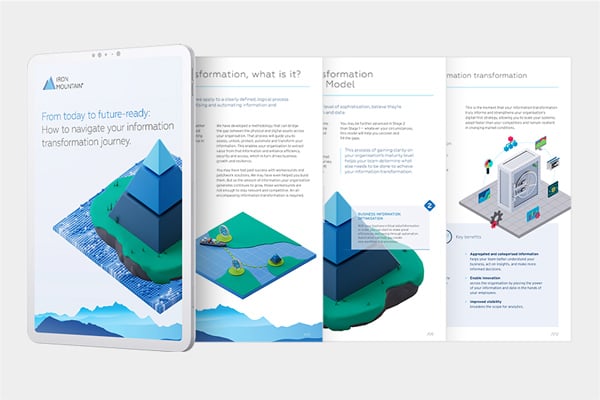The Paper-Light Office
Overcome the challenges of reducing paper documents in the office environment so that you can transform your workplace.

Introduction
Despite the ubiquity of computers, tablets, smartphones and software solutions that can capture all kinds of information, workplaces are still largely reliant on paper. Employees continue to print and use documents on a frequent and ad hoc basis, preferring the tried-and-true reliability of physical copy over their digital counterparts, and many organisations, especially larger ones, persist in using the same paper-based workflows and processes they always have, particularly in documentheavy departments like Human Resources, Legal and Finance.
It needs to change.
Relying on paper isn’t just detrimental to organisational efficiency, cost-effectiveness and information security, but when information contained on paper is locked away across hundreds or thousands of disparate paper documents scattered across scores of filing cabinets and storage rooms, harnessing it for insights or strategic decisionmaking purposes is near impossible.
The solution, though, is not to replace paper entirely. Organisations should seek the more valuable and realistic goal of going paper light, as those that attempt to go completely paper free and fail are more likely to backslide into inefficient processes and workflows than those who realise that, in 2019, paper is still very much a necessary—albeit smaller— component of the modern workplace.
The following report considers the challenges organisations face and provides practical guidance on why and how to make the journey to a paper-light future, with a focus on security, access and harnessing the value of information.
The challenges to paper reduction
A study conducted by Iron Mountain and IDG on workplace transformation found achieving a paper-lite environment is highly important for the vast majority of organisations (86%). But the main obstacles impending that goal are:
Uncertainty regarding storage:
90% of respondents stored paper records onsite, however less than half of files (46% on average) are accessed on a regular basis. This comes despite 94% of respondents claiming to have considered moving files offsite. It’s evident most organisations are aware of the inefficiencies of onsite storage, yet not knowing how or what to get rid of is impending action.
Change is hard:
Survey respondents cited numerous challenges that could fit under the umbrella of change management, such as cutting through the bureaucratic red tape to get the organisation onboard, concerns by employees about potential negative impacts to their jobs, and earning executive buy-in and support. The importance of educating employees on how paper reduction, digitisation and offsite storage can maximise the value of business data, free up office space and streamline both worker and business efficiency cannot be understated.
Confusion over the hybrid paper-digital information landscape:
There is considerable confusion and concern about how to handle the hybrid paper-digital information landscape. This is further complicated by the fact that information often moves freely between paper and digital formats, sometimes with the same information simultaneously existing in both forms, while being amended or updated in one format but not the other.
Keeping processes and employees up to date:
As mentioned in the introduction, employee preference towards paper is a considerable obstacle to paper reduction. The everyday reality of the modern office features printers and photocopiers humming away in every corner, shelves overflowing with sheets of paper and employees habituated to hard copy.
The business goals driving the commitment to paper light
The majority of survey respondents claimed they are driven to go paper light because of a desire to improve productivity and the employee experience. These drivers are explained in greater detail below, as well as how paper reduction, digitisation and offsite storage enables their achievement.
Driver one: increased employee engagement and productivity
The digitisation of key paper documents allows for faster access to vital information and the ability to automate once paper-heavy workflows (e.g., HR onboarding), ensuring employees can focus high-value tasks rather than spending time searching for documents or performing rote administrative tasks.
Driver two: control expenses while delivering high-performance workspaces
Digitisation and the subsequent removal of onsite paper storage to an offsite facility reduces the costs of onsite records management and storage and allows for the repurposing of real estate for higher-value and more efficient alternatives.
Driver three: enable a collaborative work environment that fosters innovation
Digitisation allows for the storage of all vital information into a centrally managed repository, thereby allowing employees to access and collaborate faster and more effectively than previously possible with paper. This also means that employees can work remotely, a benefit increasingly demanded from employers.
Driver four: attract and retaining top talent
Digital-first companies with high-performance, modern workspaces more effectively attract and retain top talent, particularly younger, more digitally native workers.
Driver five: foster employee engagementNT
Employees that feel they are productive and their work contributes to the organisation’s overall success (as opposed to performing busy work or rote administrative tasks that are an unavoidable reality of paper-based business) are happier and more likely to remain with the organisation.
Driver six: reduce information risk and improved information governance
While hackers make headlines, the majority of organisational information loss is due to breakdowns in processes and procedures, such as employees losing files or documents that contain sensitive information. With the average large organisation misplacing a single file every 12 seconds, it’s not hard to see how things can go south—quick.
Driver seven: enable the ability to harness the value of information
Information locked away in paper documents cannot be amalgamated and analysed to drive insights and data-driven strategies. Converting paper to digital allows for greater visibility over the totality of an organisation’s information and helps inform big data, AI and machine learning initiatives.
The journey to a paper-light future
1. Know your goal
Knowing where you are going means being clear about your business objectives. This matters because it allows you to better define your digitisation strategy and ensures that you can extract the greatest possible value from your information.
2. Know now what you store and where
There are many kinds of information, and each type has different storage and access requirements. To decide what to store and where, you need to determine the confidentiality level and legal retention period for each document type. You also need to decide who must have access to the document, and how often, and you must then take measured steps to protect your most sensitive and valuable business information. This kind of information can include such vital assets as research documents, intellectual property and customer information. Lastly, you must make sure everything is consistently indexed so you can find it quickly and easily.
3. Understand your business processes and what improvements digitisation can bring
Digitisation helps to improve business efficiency. For example, contracts represent some of an organisation’s most critical and valuable documents. They also pose special challenges for managing access and version control, confidentiality and contract integrity. Since contracts are often created and updated by many individuals throughout an organisation, these documents must be managed in a manner that allows for access from multiple locations. It is imperative that authorised parties are able to view the latest, most complete version of a contract as well as eliminate to update necessary fields that facilitate timely access and requisite reporting.
Other factors to consider include security, the ease with which information can be retrieved, format flexibility, compliance/evidentiary value and cost of conversion and storage. With this in mind, it is important that an organisation have methods in place that can measure the impact of digitisation on its business processes.
4. Bring your people with you
If your employees don’t understand or accept the changes, they may establish a workaround that could leave information less secure. It is critical to engage staff in the paper-light process. Try setting up a working group that includes key stakeholders as well as end users. In addition, make efforts to ensure that the paper-light processes that are implemented provide immediate benefit and are difficult to bypass. Be sure to create initiatives that help promote success and demonstrate business value across departments. Successful pilots can be used to gain support for broad implementation and companywide adoption.
5. Consider compliance and legal requirements
It is worth taking the time to survey and understand your regulatory landscape. Be sure that the latest legal and regulatory requirements are built into your paper-light program from the outset. Digital records are often held in cloud software or on a server at a data centre, and it is important to know exactly where these facilities are geographically, as data protection laws can vary across regions. Also, be aware that certain types of information must be retained within the country of origin.
In addition, digital documents, including scanned paper files, can now be presented as evidence in legal proceedings. However, to ensure admissibility, digital information must be managed securely throughout its lifetime. So if you’re thinking about replacing paper records with digitised documents, you need to ensure that the whole document lifecycle – from capture through to transformation, storage and disposal – follows procedures that assure legal admissibility. This is yet another area in which a good records management partner can help you.
6. Consider cost
The full cost of managing information may not always be obvious, yet it can be considerable. Experts can help identify inefficiencies, such as paying for storage that isn’t needed or pinpointing expensive management systems. Costs can escalate rapidly if you try to do everything yourself or if you try to do it all at once. It is not necessary, for example, to scan all of your company’s documents. Instead, it’s more important to scan what you value most and then archive the rest. It’s also worth remembering that for some processes (particularly those involving less active information) paper may indeed be the more suitable and most cost-effective storage option. In these cases, keep in mind that images can be always made available on demand.
7. The importance of preparation
To ensure you don’t lose any of your newly digitised information, it’s important to plan and prepare before you even get started. Such preparation includes determining your meta-data plan: implementing tags, labels and indexes that will help you to quickly locate the digital document you need. Also, be sure to determine where the information will be stored (i.e. in your own repository or a hosted archive).
8. In-house or outsource
The decision to manage and store digital files on or offsite will vary according to the company. The need for business continuity is an important consideration in this case. If you’re planning to close offices or reduce staff, there is a risk that paper could be left behind. This could constitute a major security and data protection breach. Consider the in-house expertise you might have available compared to the capability offered by an external provider. Freeing space for more revenue-generating activities can be a key motivation to outsource.
9. Don’t forget inbound
What about all the new paper that flows into your organisation every day? Leading organisations consider management plans that rely on information garnered from both inbound paper documents and archived paper records. Managing inbound information will help you streamline your downstream business processes and limit backlogs. Many organisations struggle to manage this inbound workflow efficiently because their information exists in different formats and is managed by different teams. Yet consider this: if a company wishes to improve its customer service process, an imaging solution can enable frontline customer service agents to immediately identify customer interactions that take precedence in order to better prioritise work. Having access to the right customer information means faster response times and reduced issue resolution time, which can in turn cut back on costs. Regardless of the industry, when it comes to customer problem resolution, speed always has a direct impact on revenue.
You must determine exactly when and how your teams need access to information. The right information management strategy for your business should take into account your existing business process and give you better control over your information.
10. Consider potential of big data
The volume, variety and velocity of information are increasing. Few organisations will remain unaffected by this rapid growth. Your document management processes need to be able to accommodate these ever expanding volumes. Make your information challenge manageable by segmenting and prioritising according to the value, risk and compliance requirements of the information you possess. Getting a strategy in place is the most important step – so opt for progress over perfection. Whatever you decide, make sure your information management plan includes a reliable, long-term storage solution, and that your company can easily extract insight from archived data.
Paper light case studies
Discover how these organisation are leveraging Iron Mountain to reduce their paper burden and streamline business operations
Case study - cost reduction
Jacobs Engineering
Challenge
Jacobs Engineering identified its records management policy and practice as an area for potential cost savings. Lack of standardised archiving processes at the firm resulted in difficulties accessing important documents, a variety of disorganised storage locations and unknown archiving costs.
Solution
By consolidating its records with an Iron Mountain Records Management program, the professional technical services firm achieved process consistency and improved document security and access.
Value
This reduced the administrative burden of managing information and streamlined processes, which have since exceeded expectations in terms of cutting costs.
A need to reduce risk and manage security. Many organisations are unaware that an office is probably not the best place to store necessary documents. Instead, comprehensive information management allows for improved compliance and can reduce risk of data loss or exposure. In addition, a records management program that incorporates digitisation and offsite storage of paper documents can give your company added piece of mind and protect against unforeseen disaster. For example, offsite storage can reduce opportunities for unauthorised access or theft, while digitisation allows endto- end document tracking and authentication.
A need to harness the value of information. The ability to access and analyse all types and formats of information allows an organisation to turn data into intelligence. This is important news, considering companies are only just learning that the consolidation and indexing of records can help identify money-saving trends in customer behavior. Such analysis can also improve customer relations and supply chain management, and can likewise make the business more agile and responsive and allow employees to make more informed decisions.
Our studies show that the perceived business benefits of harnessing information value include a greater understanding of customer segments in marketing (52% of firms surveyed), improved services and systems in IT (49%), enhanced problem resolution in customer service (53%) and an ability to respond more quickly and effectively to legal challenges (61%).
Gartner analyst Doug Laney has shown that organisations that are ‘information-centric’ and that make the most of their information can double their market value.
“The most important thing was having a service plan that worked for us. Iron Mountain proved very flexible in adjusting its processes to take account of our unique needs. The net result is a cost reduction of [about $125,000] over the first two years, with recurring savings going forward.”
- Tom Shaw Business Process Manager, Jacobs Engineering
Case study - harnessing the value of information
SunGard
Challenge
SunGard Availability Services provides operations support to IT departments that need to keep mission-critical information up and running. The company was looking for a more consistent automated processing and tracking solution to help eliminate the inefficiencies associated with manual, paper-based Accounts Payable invoice processing. At the time, 90% of SunGard Availability Services’ invoices were paper-based.
Solution
Iron Mountain introduced a new AP invoice processing solution which eliminated paper and routed e-invoices via automated workflow to authorised approvers for matching and exception handling. All of this is now managed from a single dashboard with self-service for users, offering information on-demand, an online audit trail and workflow status and transaction history.
Value
SunGard now has clear visibility into invoice status and real-time reporting capabilities that allow for customised reports that provide the required level of detail to capture early payment discounts and realise the savings negotiated by procurement. In addition, SunGard staff can now work to review and approve invoices and update budgets at any time, avoiding a crunch at the end of the month. What’s more, 90% of SunGard’s invoices are now entirely paperless.
“The Iron Mountain solution gave us workflow, approval authority and self-service capabilities. Not only are we saving time but there is greater visibility and accountability company-wide.”
- Don Meyers, Director Of Accounting And Finance Sungard Availability Services
Sources
Workplace Transformation Survey. Research study undertaken in January 2019 by MarketPulse Research on behalf of Iron Mountain. Marketpulse interviewed a total of 200 senior business executives in the U.S. responsible for decisions around the use of real estate and/or enhancing employee productivity.
Getting Started with Digital Transformation, Iron Mountain, 2018
Featured services & solutions
Related resources
View More Resources

